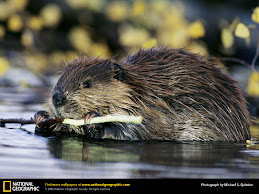Guess which gets more press coverage.
Not Earth Day. Coverage will be limited to the president half-heartedly standing in a remote national park quoting Teddy Roosevelt while announcing some cleverly named initiative. Find the photo op buried on page 17 of Wednesday’s paper. Page 1? Primarily the election.
But hang on. While the state of the environment is grim this Earth Day—the climate is changing, species vanishing, glaciers melting, sea levels rising, rainforests burning, coral reefs bleaching and dying, deserts spreading, population rising—if you place your finger on the pulse of popular culture, you can feel it: a green tsunami rising.
In fact, the word green is suddenly everywhere: green roofs on green buildings, green products on web sites, presidential candidates debating “green collar jobs,” a new phrase that entered the lexicon only this spring. In fashion, green is the new black, and New York Times columnist Thomas Friedman reminds us that “green is the new red, white and blue.” A rainforest has been pulped to produce Vanity Fair’s annual green issue, featuring a half-naked Madonna, the green goddess undressing, and my Philadelphia Inquirer has just launched GreenSpace, a new column showcasing the explosion of green.
Kermit got it wrong: it’s easy being green. Or at least, in shallow America, it’s easy to market green. But dig deeper.
Al Gore, fresh off his Nobel Prize, has launched the $300 million We global warming campaign. Plug-in hybrid cars are coming on fast as the next generation of transport. Organic food options are exploding: Wal-Mart is the largest seller of organic food, Gallo Brothers the largest organic wine producer. Wind power is smokin’ hot, alternative energy is already hyped as the next bubble, the coal industry is pouring buckets of money into convincing us coal is clean, solar is back from the dead, and BP, the oil giant, touts its initials as meaning “Beyond Petroleum.”
Interest in the environment is resurgent. This Earth Day, we are witnessing the dawn of the third wave of environmental activism.

The first dates to the 1970 teach-in that was the first Earth Day, then the largest mass demonstration in history (in archival photo at right, this protester offered a comment prediction of the time). Lake Erie was dead, Cleveland’s Cuyahoga River caught fire, Rachel Carson’s Silent Spring jumpstarted the pesticide debate, bald eagles were vanishing from eggshell thinning. Nixon became the First Environmentalist, reluctantly signing bills banning DDT, reauthorizing the Clean Air and Clean Water acts, and creating the EPA. Scratch any environmentalist of a certain age, and he’ll trace his interest in the environment to that Earth Day.
The second wave broke across pop cultural shores during the first Bush presidency. Medical waste washed up on beaches alongside dead dolphins; the garbage barge took its world tour hoping to unload its half-ashed cargo. One landfill closed every day. Yellowstone burned, drought gripped the South, the Exxon Valdez crudely vomited into Prince William Sound, and the ozone hole yawned wide.
The culture responded. In December 1988, Time magazine skipped its usual Person of the Year honor to anoint Earth as Planet of the Year. Curbside recycling took off, a global summit on CFCs produced a workable treaty, “50 Simple Things You Can Do to Save the Earth” embeds itself atop the bestseller list, and 120,000 Philadelphians—a record!—gathered in Fairmount Park for a monstrous EarthFest ‘90. The UN’s Earth Summit assembled the largest gathering of world leaders ever.
Fast forward to 2008: green is hot again. But Earth Day is not—not yet, anyway—and environmental issues will not decide Tuesday’s primary. Once again, a Clinton is telling us it’s the economy, stupid.
But Americans are counterpunchers—we respond best when smacked in the gut. If syringes and Flipper litter beaches, we suddenly invent plastic recycling and dolphin-safe tuna. If planes crash into the World Trade Center, we invade Iraq. The next—and final—wave of environmental activism begins when some big mediagenic event occurs, like the last mountain gorilla being hacked to death, or a monstrous iceberg calving off Antarctica, or polar bears vanishing under an ice-free Arctic Ocean. We’re waiting for the punch, and when it comes, the counterpunch will be huge.
For as I take our collective pulse, a groundswell of support for environmental issues is forming. And just in time, for the four horsemen of a global apocalypse—global warming, species loss, water shortages, and overpopulation—are galloping swiftly toward us.
The green tsunami will rise, and the next president will have to react. By the 2012 election, green issues will be transcendent, the global environment standing alongside Islamo-fascism as the Twin Towers through which we navigate the 21st century.
In 2012, it will be the ecology, stupid, and we’ll be locked in a race to rescue the planet. As Pennsylvanians head into the election booth on Tuesday, I hope we consider which candidate can lead us into that environmental future, which can help us win that race, which can best surf the green tsunami rising.


No comments:
Post a Comment